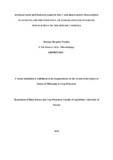| dc.description.abstract | Root-knot nematodes (RKN), Meloidogyne spp. and Fusarium oxysporum f. sp. lycopersici
(FOL) that cause vascular wilt, are among the most important diseases affecting tomato
production in Kenya. The aim of this study was to investigate interactions between RKN and
FOL in tomato cultivars, and explore methods of their control. A survey was conducted in
Mwea West Sub County on tomato production practices and diseases that affect the tomato
crop. Soil was sampled from 119 farms and was analysed for prevalence of different types of
nematodes genera. Experiments were carried out in the greenhouse to test six different
tomatoes cultivars reaction to Meloidogyne javanica and four different isolates of Fusarium
wilt, and also test effect of interaction between Fusarium oxysporum f. sp. lycopersici (FOL)
and M. javanica at different inoculum densities of 500, 1000, 2000 and 3000 second stage
juveniles (J2s) in two tomato cultivars Rambo F1 and Prostar F1. Efficacy of the biological
control agents Trichoderma harzianum (TH) and Purpureocillium lilacinum (PL) and organic
amendment neem in the management of FOL and the root-knot nematode M. javanica was
assessed under greenhouse conditions. Field survey data showed that RKN had a prevalence
rate of 3.8%, while the actual study in field established that among all nematode genera,
Meloidogyne spp. was the most abundant at 15.86%. Fusarium verticillioides was isolated
from infected tomato stems collected from tomato farms together with Fusarium oxysporum
f. sp. lycopersici and F. oxysporum. In the evaluation of different tomato cultivars reaction to
Meloidogyne javanica, the results showed that, Rambo F1, Roma VFN, Prostar F1 and Cal J
were better hosts to M. javanica with high galling indices and greater reductions in growth,
while Kilele F1 and Oxly were less susceptible. The tomato cultivars Prostar F1, Roma VFN
had 100% disease incidence scores when inoculated with isolate F41 of FOL with cultivar
Rambo F1, being the least susceptible, at an incidence rate of 16.7%. When the cultivar
Prostar F1 was inoculated with the isolate of FOL and different inoculum levels of M.
xviii
javanica, there was progressive reduction in growth and increase in FOL disease severity
with increasing nematode inoculum levels. In cultivar Rambo F1, the FOL disease severity
was insignificant even at high nematode inoculum levels and there was less reduction in
growth in this cultivar compared to Prostar F1. In vitro dual culture plate tests showed
significant mycelia inhibition of FOL by TH and PL. The treatments, TH, PL, and PL-TH
significantly controlled FOL disease in the cultivar Prostar F1. The resistance of the cultivar
Rambo F1 sufficed to prevent infection by FOL. The treatments TH, PL, PL-TH significantly
controlled the M. javanica J2s in Prostar F1 and Rambo F1 tomato cultivars. Neem enhanced
the efficiency of the fungal biological control agents such that the treatments application with
neem and fungal antagonists’ performed better than those without neem in the control of FOL
wilt disease and M. javanica J2s. The fungal antagonists and neem were equally effective in
controlling Fusarium wilt in sterile and non sterile conditions while being less effective in the
control of M. javanica in the cultivar Prostar F1. The survey established the need to create
awareness on RKN and FOL to prepare farmers to be receptive to new methods of control of
FOL and RKN. There is need of surveillance by all agriculture stakeholders to check on the
progress of F. verticillioides as a new pathogen that can infect tomato and other crops. The
possible effects of M. javanica and FOL interaction in an FOL resistant cultivar Rambo F1,
implies that the use of a resistant cultivar integrated with neem and a fungal antagonist is a
viable option for the control of FOL and RKN disease complex. A combined application of
biological control agents should only be used after pretesting to ensure that they do not
inhibit one another and are compatible, especially if their modes of action against the
pathogen are similar. The fact that biological control agents and neem were equally effective
in controlling Fusarium wilt in non sterile soil as in sterile, although not as effective in the
control of RKN in non sterile soil conditions, suggest there is potential to use them in non
sterile natural soil conditions, as an alternative to use of chemicals pesticides. | en_US |



